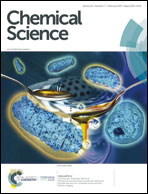Oxygen uptake in complexes related to [NiFeS]- and [NiFeSe]-hydrogenase active sites†
Abstract
A biomimetic study for S/Se oxygenation in Ni(μ-EPh)(μ-SN2)Fe, (E = S or Se; SN2 = Me-diazacycloheptane-CH2CH2S); Fe = (η5-C5H5)FeII(CO) complexes related to the oxygen-damaged active sites of [NiFeS]/[NiFeSe]-H2ases is described. Mono- and di-oxygenates (major and minor species, respectively) of the chalcogens result from exposure of the heterobimetallics to O2; one was isolated and structurally characterized to have Ni–O–SePh–Fe–S connectivity within a 5-membered ring. A compositionally analogous mono-oxy species was implicated by ν(CO) IR spectroscopy to be the corresponding Ni–O–SPh–Fe–S complex; treatment with O-abstraction agents such as P(o-tolyl)3 or PMe3 remediated the O damage. Computational studies (DFT) found that the lowest energy isomers of mono-oxygen derivatives of Ni(μ-EPh)(μ-SN2)Fe complexes were those with O attachment to Ni rather than Fe, a result consonant with experimental findings, but at odds with oxygenates found in oxygen-damaged [NiFeS]/[NiFeSe]-H2ase structures. A computer-generated model based on substituting −SMe for the N-CH2CH2S− sulfur donor of the N2S suggested that constraint within the chelate hindered O-atom uptake at that sulfur site.
![Graphical abstract: Oxygen uptake in complexes related to [NiFeS]- and [NiFeSe]-hydrogenase active sites](/en/Image/Get?imageInfo.ImageType=GA&imageInfo.ImageIdentifier.ManuscriptID=C8SC04436H&imageInfo.ImageIdentifier.Year=2019)
- This article is part of the themed collection: Most popular 2019-2020 inorganic, main group and crystal engineering chemistry articles


 Please wait while we load your content...
Please wait while we load your content...